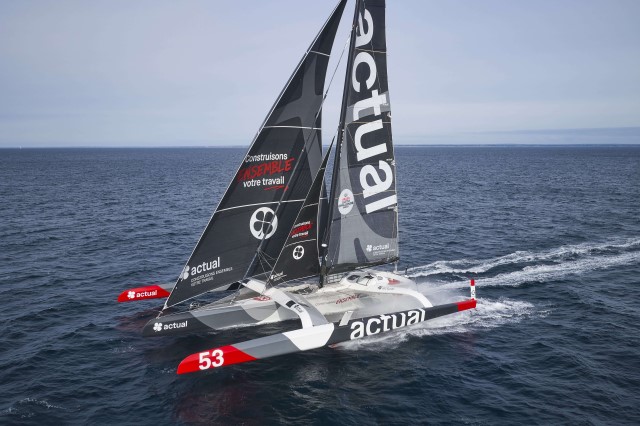BREST, FRANCE: Yann Eliès. The renowned French skipper has three victories on the Solitaire du Figaro to his name and also three wins in different classes in the Transat Jacques Vabre. Most recently he just finished second on the IMOCA Paprec-Arkea with Yoann Richomme. He has competed in two Vendée Globes and been part of two Jules Verne Trophy record attempts on the ARKÉA ULTIM CHALLENGE-Brest leading boat Edmond de Rothschild.
Eliès has his take on these boats, their reliability, and especially on this course and this Indian Ocean that the skippers of the ARKÉA ULTIM CHALLENGE-Brest are descending into.
This race is finally the result of years of hopes, development, doubts, of promises. What is your view that it is all happening and is well underway?
“It reminds me of The Race in 2000 (crewed race around the world). These are the type of races that hit the headlines, a new type of event that disrupts the trends of the moment. It has a new, exceptional aspect, and holds the idea of being a pioneering challenge. These kinds of events are good! There was only one edition of The Race, I am convinced that this will not be the case for the ARKÉA ULTIM CHALLENGE-Brest.”
We saw a head-to-head sprint the first week, with a duo racing side by side… Was that a scenario you anticipated?
“Well they raced the easy bit head to head, they were blessed at the start of the race. It can be complicated. We sometimes set off in big winds and seas at this time of year but they had easy conditions. It’s from now on it’s going to get complicated. We were lucky to have seen such a fight, a race. Any thoughts it would go on head to head round the world like that is a bit of a dream. But here we are now entering the new phase: they are getting into the adventure part.”
“Appendages are the Achilles Heel of an ULTIM”
There has been damage to Armel and Tom Laperche. What did you think?
“Unfortunately, it is normal. These are boats that are novel and complex and which have never yet sailed around the world in this flying configuration. The teams are still trying – and this is normal – to know where to put the cursor. And here we are still wondering if it will be possible or impossible to go to the finish line…”
And there is always this element of uncertainty, particularly linked to unidentified floating objects.
“We need to be able to detect them better. I think that establishing these cetacean protection zones is a good thing and I am sure that we will no longer question their usefulness in the years to come.. It’s like the seat belt in a car!”
We know that teams try to anticipate everything, they check everything several times and reinforce components… Why is that not enough?
“Because the Achilles heel of an Ultimate is these six appendages that are exposed in the water. We cannot imagine the physical constraints they undergo. It’s the same principle as a car tyre on the Dakar rally: all it takes is one misplaced stone on the course and it punctures. Except that in an Ultim, it’s impossible to stop and repair it yourself. Structurally, these are state-of-the-art boats but all it takes is a grain of sand to stop them from functioning properly, like the hydraulic problem that Armel Le Cléac’h had to deal with. The Indian Ocean can see these explosive cocktails”
You experienced the Big South in the Vendée Globe, in The Ocean Race… How do you describe what it feels like to sail in the Indian Ocean?
“The hardest part is getting into it. Before you enjoyed idyllic conditions, in a T-shirt, on a flat sea. And then in just a few hours, things get tougher: the sea becomes cold, the wind denser. Our human body has to adapt quickly. We have to deal with the Agulhas Current, the depressions that come down from Africa and mix with the freezing air. It forms an explosive cocktail for machines and men and women. Those who survive the week getting into the Indian Ocean have a good chance of reaching Cape Horn. But even there damage can occur, the ocean is rough and it’s never easy.”
In 2017, you completed the Vendée Globe in 80 days and three hours. Does the ARKÉA ULTIM CHALLENGE-Brest shake up the perception of time?
“Yes totally! The Equator in 6 days, the Cape of Good Hope in 13 days, and Cape Horn in 35 days. It’s a dream sequence. It is exceptional and it is disturbing. During my first trip around the world, I had difficulty imagining the whole of the globe, telling myself that we could go around it. And then you realize that it’s not so, so long and not that big after all.”

You have sailed several times aboard the Maxi Edmond de Rothschild. How do you describe the sensations on board?
“Well for a start It goes super fast! The appendages make noise, we hear the foils moving in their wells. There are a lot of alarms. They ring as soon as there might be a problem. If the boat doesn’t heel a monohull, you have longitudinal pitching movements, everything is lateral. But it’s incredibly enjoyable. Sailing at 35, 40 knots, getting closer to 800 miles covered in a day. They are sacred machines!”
Is there still a raw pleasure in going ever faster in the current context?
“Above all, we must remember that the dream – and we are starting to live it – is that all of these innovations trickle down into the sailing cargo transport industry. Ocean racing can succeed in opening up a whole gamut of possibilities in this area and we can only celebrate that.”

Text Credits: ARKEA Ultim Challenge
Video Credits: NEFSEA Productions/PolaRYSE

